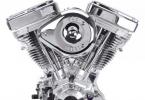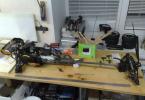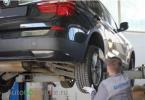Steering
The steering control is called a set of devices that rotate the driven wheels of the car.

Fig. 2. Steering controls with independent (A) and dependent (b) controlled pendants:
1 - steering wheel; 2 - shaft; 3 - steering (mechanism); 4 and 12-pin;
5, 9, 11 and 14 - levers; 7 - Cup; 6, 8, 10, 13 and 15 - traction
Traumatic steering
In addition to the steering wheel with a recessed hub and two spokes, which significantly reduces the severity of the injured injuries when they hit, a special energy absorbing device is installed in the steering mechanism, and the steering shaft is made compound. All this ensures a slight movement of the steering shaft inside the car body with a frontal collision with an obstacle.

a - the folding steering shaft; b - bellows; in - perforated shaft; 1- bracket; 2 - cardan hinge; 3 - cylinder; 4- trumpet
In the trauma-safe steering controls of passenger cars, other energy absorbing devices are used, which connect the composite steering shafts: rubber couplings of a special design, a device such as a Japanese lantern, in the form of several longitudinal plates welded to the ends of the connected steering parts. In collisions, the rubber coupling is destroyed, and the connecting plates are deformed, reducing the movement of the steering shaft inside the body's cabin.
Steering gear
The steering is called the mechanism that converts the rotation of the steering wheel to the translational movement of the steering drive, which causes the rotation of the controlled wheels. It serves to increase the driver's effort attached to the steering wheel, and transfer it to the steering drive.
An increase in the force attached to the steering wheel is occurring due to the gear ratio of the steering mechanism. The transfer number of the steering mechanism is the ratio of the rotation of the steering wheel to the corner of the shaft of the steering tower. Depending on the type of car, it is 15 ... 20 in passenger cars and 20 ... 25 in trucks and buses. Such gear ratios for 1 ... 2 full turnover of the steering wheel provide rotate controlled wheels for maximum angles (35 ... 45 °).
Various types of steering mechanisms are used on cars.


a - worm-roller; b - vinatoroeh; in - wheels; 1 - worm; 2, 4 and 9 - shafts; 3 - roller; 5 - screw; 6 - nut; 7 - ball; 8 - sector; 10 - gear; 11 - Reika
Steering wheel drive
The steering wheel drive is called a system of thrust and levers that communicates the controlled wheels of the car with a steering mechanism. It serves to transmit effort from the steering mechanism to controlled wheels and ensure their correct turn.
On vehicles use different types of steering wheel drives.

The main part of the steering drive is steering trapezium
The steering trapezium can be anterior or rear depending on its location in front of the axis of the front controlled wheels (see Fig. 2, a) or for it (see Fig. 2, b). The use of a steering wheel with anterior or rear steering trapezium depends on the layout of the car and its steering. At the same time, the steering wheel can be with a continuous or incisional steering trapezium depending on the type of suspension.
The continuous steering trapezium has a solid transverse steering, connecting controlled wheels (see Fig. 2, b).
Such a trapezium is used with the dependent suspension of the front controlled wheels on trucks and buses.
A split steering trapezium has multiple transverse steering, connecting controlled wheels (see Fig. 2, a).
It is used with independent suspension of controlled wheels on passenger cars.
Steering amplifier
The steering amplifier is called a mechanism that creates under the pressure of liquid or compressed air an additional force on the steering wheel, which is necessary to rotate the driven wheels of the car.

1 - spool; 2, 3 and 11- oil carriers; 4- springs; 5-wheel; 6 and 9 - traction; 7 and 8- levers; 10 - piston; but...g. - cameras; A and B - cavity; B - tank; GG - HydroNesos; PM - steering mechanism; Gr - hydraulic distributor; Hz - hydraulic cylinder
Steering designs
Left, trauma-safe, without amplifier. The safety of the steering is provided by the design of the intermediate shaft of the steering wheel and the special fastening of the steering shaft to the car body.

1 and 3 - traction; 2 - Cup; 4 and 7 - levers; 5 - coupling; 6 - fist; 8 and 16 - brackets; 9 - Bearing; 10 - pipe; 11 and 13 - shafts; 12 - Carter; 14 - column; 15- steering track; 17 finger; 18 - case; 19 - tip; 20 - insert; 21 - Spring; 22 - plug
The steering mechanism of the passenger car VAZ of high patency:
1 - Cup; 2 and 13 - cuffs; 3- sleeve; 4 - Carter; 5 and 12 shafts; 6 - roller; 7-screw; 8-nut; 9- traffic; 10 and 16-covers; 11 - worm; 14 and 18 - bearings; 15- adjusting gaskets; 17-axis

1 - lever; 2 - hinge; 3 and 5 - thrust; 4th 34 - nuts; 6 finger; 7 and 13- covers; 8 - insert; 9 and 33 - springs; 10 and 20 - bolts; 11- bracket; 12 - support; 14 and 15 - plates; 16 and 17 - sleeves; 18-rail; 19- Carter; 21 - coupling; 22-quenching device, 23 - steering wheel; 24, 29 and 31 - bearings; 25 - shaft; 26-column; 27- bracket; 28 - Cap; 30- gear; 32- Emphasis
03/19/2013 at 05:03.
This is the main element of the steering system, binding the shaft of the steering wheel and the craving of the steering drive.
The steering mechanism performs the following functions:
- an increase in the effort attached to the steering wheel;
- transmission of force steering;
- Returning the steering wheel to the neutral position, when removing the load and the absence of resistance.
The steering mechanism is a mechanical transmission, in other words, the gearbox. The main parameter of the steering mechanism is a gear ratio, which is determined by the ratio of the number of teeth driven gear to the number of teeth leading.
There are three types of steering steering steering mechanisms depending on the type of mechanical transmission: wheels, worm, screw.
1. Rack steering mechanism
Design
This is the most common type of steering mechanism installed on passenger cars. The Rack Steering Mechanism consists of:
- gears installed on the steering wheel shaft;
- Ruttle racks of a toothed type, connecting with the gear.
Rack mechanism is constructively simple, has a high efficiency and high rigidity. However, such a mechanism is sensitive to shock loads due to road irregularities and prone to vibrations. This type of mechanism is set on vehicles with an impeller with independent suspension controlled wheels.
Principle of operation
1. With the rotation of the steering wheel, the steering rack moves to the left and right.
2. With the movement of the steering rack, there is a movement of the steering drive attached to it and turn the car wheel.
2. Worm Steering Mechanism
Design
The worm mechanism consists of:
- global worm (worm with variable diameter);
- steering shaft;
- Roller.

A lever (compartment) is installed on the shaft of the roller behind the wheel of the steering mechanism, which is associated with the steering drive.
The worm mechanism has a smaller sensitivity to shock loads, providing large angles of rotation of the wheels, the result of which is the best maneuverability of the car. But the worm mechanism is complicated in the manufacture and its value is great. This mechanism requires periodic adjustment due to a large number of compounds.
Worm mechanism is used on high-passing machines with dependent suspension controlled wheels and light trucks.
Principle of operation
1. With the rotation of the steering wheel, the roller is moving along the worm (rolling), swinging the bump.
2. The thrust of the steering drive occurs, due to which the wheels are rotated.
3. Screw steering mechanism
Design
The design of the screw mechanism includes:
- screw on the steering wheel shaft;
- Nut, which moves along the screw;
- gear rail, sliced \u200b\u200bon the nut;
- toothed sector, which is connected to the rail;
- Steering tush, located on the shaft of the sector.

The main feature of the screw mechanism is to connect the screw and the nuts with the help of balls, which leads to less friction and wear of the pair.
TO Manager:
1 Treaty cars
Purpose and steering device
Purpose of the steering. The steering is designed to ensure the movement of the car at a given driver direction. It consists of a steering mechanism and steering drive. The design of the steering mechanism and the steering drive must ensure the accuracy of the car control, the reliability of all nodes and parts * Do not require the driver the costs of great effort and not transmit to the steering wheel of the shock perceived by the wheels of the car.
In order for the car to move on the rotation without a side slip of the wheels, all the wheels must make a combination of arcs described from one center lying on the continuation of the rear axle of the car. In this case, the front controlled vehicle wheels must be rotated to different angles. Internal (with respect to the center of rotation) The wheel must be turned to a larger angle, the outer wheel is to a lower angle. Such a rotation scheme is achieved by using a trapezium with hinge connections in the steering drive.
Steering gear. There are several types of steering mechanism. The most common of them are worm - video, worm - sector and screw - ball nut.
Worm-type wheelchair - roller applied on most passenger cars and many trucks. In fig. 1 shows the steering device of this type of car gas -53a. In the steering mechanism crankcase on two conical roller bearings, a global worm rotates, installed at the end of the steering shaft.

Fig. 1. The rotation scheme of the driven wheels of the vehicle: A - the angle of rotation of the outer wheel, p is the angle of rotation of the inner wheel; 1 - transverse steering, 2 - front axle, 3 - Rotary Rotary Rate Levers
In engagement with the worm includes a three-grade roller, rotating on two needle bearings. Between the bearings installed a spacer sleeve. The axis of the roller is fixed in the head of the tree tower shaft. Opportments of the shaft of the steering tower serve on one side the roller bearing, and on the other - the bronze sleeve. The steering tump is connected to his shaft with small slots and is fixed with nut 15. The end of the tree tower shaft is sealed with a gland. To adjust the tightening of the steering shaft bearings under the bottom cover of the crankcase, gaskets are installed.
The engagement of the working pair of the steering mechanism is designed in such a way that with a position corresponding to the straight-line movement of the car, the free course of the steering wheel should be missing. As the steering wheel turns into one direction or another side, the gap between the worm and the roller and the free stroke of the steering wheel increase. The adaptation of the engagement worm with the roller is carried out by offset of the shaft of the steering tower in the axial of the reign using the adjusting screw. Screw installed in the side lid! Carter steering mechanism, outside closed with cap nut 8 and fixed with a retained puck fixed.
Worm-type steering mechanism - roller provides the smallest friction losses. This requires a smaller driver's effort to control the car and reduced wear of parts.
Cars of heavy loading capacity, the steering mechanism has a greater gear ratio to facilitate control, and there is no significant specific pressure between the surfaces of the working pair.
In this regard, on such cars, the worm-type steering mechanism is used - the sector with a large surface of the engagement or the mechanism with two working pairs of the screw type - nut and rail - sector.
Worm-type steering mechanism - the sector is most simple in design. In engagement with a global worm enters a side sector in the form of a part of a gear with spiral teeth, made at the same time with a tower shaft. The shower in the engagement worm with the sector is not constant. The smallest gap value corresponds to the average steering wheel.

Fig. 2. Wall-roller steering mechanism: 1 - mechanism crankcase, 2 - Tree shaft, 3 - three-grade roller, 4 - gasket. 5 - Worm, B - Cork, 7 - Retained washer, 8 - Cap nut, 9 - Roller axis, 10 - shaft steering wheel, 11 - Adjusting screw, 12 - Stop pin, 13 - Oil, 14 - steering tump, 15 - Nut, 16 - Bronze bushing
When turning the steering wheel in one or the other side, the size of the gap increases depending on the angle of rotation, reaching the maximum value in extreme positions. Such a gap distribution facilitates maneuvering with large steering corners and is achieved by a gradual decrease in the height of the sector's teeth from the middle to the extreme points. When assembling, the installation of the mechanism is correctly checked by the labels available on the worm and sector.
The sump is planted on the shaft rotating in two needle bearings, between which the spacer sleeve is installed. In this case, the shower in the engagement worm - the sector is easily controlled by the change in the thickness of the thrust washer located between the side surface of the sector and the cover of the steering mechanism.

Fig. 3. Steering Mechanism with Built-in Hydraulic Pump: 1 - Pump Drive Pump, 2 - Pump Hydraulic Pump, 3 - Pump Tank, 4 - Filter, 5 - Filter Safety Valve, Plum Blide, Exposure Valve, 8 Safety Valve, 9 - High Pipeline Pressure, 10 - rack piston. 11 - steering mechanism. 12 - Screw, 13 - Ball, 14 - Ball nut, 15 - Thrust ball bearing, 16 - control valve body, 17 - check valve, 18 -Zolnik, 19 - adjusting nut, 20 - spring washer, 21 - springs of reactive plunger, 22 - jet plunger, 23 - gear sector, 4 - Tshaka, 25 - Pump stator, 26 - Rotor pump, 27 - cavity suction, 28 - Power cavity, 29 - blades
The steering mechanism of the type of screw - nut and rail - the sector is applied on many trucks (ZIL -130, KAMAZ of all models, etc.), it is shown in fig. 3.
The shaft of the steering mechanism, installed in ball bearings, has at the end of the screw. The ball nut is fixed in the piston-rail. When turning the steering shaft, the rake-piston moves along its axis. The axial movement of the rack-piston having the outer surface of the teeth causes a rotation of the toothed sector installed on the shaft of the boss. The sump through the steering wheel drives the front wheels.
In the nut and screw are semicircular screw grooves. Balls are freely rolled in them. So that the balls do not fall out of the screw grooves, stamped guides are inserted into the groove grooves, which are a closed chute. The rotation of the screw causes the rolling of the groove balls. At the same time, they come out on one side of the nut and return to it from the opposite side. The presence of balls greatly facilitates the turning of the shaft of the steering mechanism.
The steering mechanism is connected to the steering column shaft with two hinged cardan shaft. This is caused by the difficulty of placing the steering of the usual design by car, which has a V-shaped engine and the cabin close to it.
Intersective steering column. With frontal blows of the car, in the event of an accident, the driver can be injured with a steering wheel. In order to maximize the danger of the driver's blow to the steering wheel, the herbal-safe steering column is installed on the passenger cars of the latter models. So, by car "Moskvich-1500" the steering column of the telescopic type consists of tubular parts that can enter one to another.
When you hit the steering wheel, the lower part of the steering shaft receives axial movement in elastic with slotted sleeves, and the upper and lower parts of the steering column pipe are included in the middle part of the pipe. The impact energy is absorbed by friction between moving items.
The steering wheel itself with a recessed hub and soft lining reduces the danger of hitting it.
The driver, watching the road, controls the car with the steering. Purpose of the steering is to change the direction of the car's movement so that when turning the car, the combination of its wheels on the road happened if possible without slipping. The latter is very important, since the side slip of the tire causes their elevated wear and worsens the stability of the vehicle's movement.
Steering consists of a steering mechanism and steering. Sometimes an amplifier is turned on in the steering.
The steering mechanism is called a slowing transmission, transforming the rotation of the steering wheel shaft into rotation of the tower shaft. This mechanism increases the driver's force attached to the steering wheel and makes it easier to work.
The steering drive is called the system of thrust and levers, which combines a car with a steering mechanism. The steering wheel drive (or steering) serves to rotate the driven wheels of the car at different angles, which is necessary for rolling wheels without lateral slipping. The steering trapezium is a hinge quadrilateer, formed by the central part of the front axle, a transverse steering tower and swivel levers. The latter are connected to the swivels, on which controlled wheels are planned.

Fig. 4. Car turning scheme and steering trapezium: A - rotation scheme; B - Scheme of the steering trapezium; R - Radius of rotation of the wheels; 1 to 8 - swivel trumps; 2 and 6 - swivel levers; 3 - front axle; 4 - transverse steering; 5 - lever
The steering mechanism is connected to the left swivel pin, longitudinal steering and lever. The steering fever moves the longitudinal steering thrust or backward, causing it to rotate the controlled wheels to the left or right.
Due to the presence of a steering trapezion, controlled wheels are rotated at different angles: internal (nearest to the center of rotation) wheel to a larger angle than the external one. The difference in the angles of rotation is determined by the value of the angle of inclination of rotary levers of the trapezoid.
The steering drive of the front controlled wheels shown in Fig. 4, complies with the arrangement of the steering wheel adopted on domestic cars with right-hand motion.
TO Manager: - 1 Treaty Cars
The basis of the steering of any car is the steering mechanism. It is designed to transform rotational movements of the steering wheel into reciprocating steering drives. In other words, this device turns the turns of the steering wheel into the desired movement of the thrust and rotate the controlled wheels. The main parameter of the mechanism is the gear ratio. And the device itself, in fact, is a gearbox, i.e. Mechanical transmission.
Mechanism functions
Steering ReikaThe main features of the device are:
- conversion of effort from the steering wheel (steering wheel);
- transferring the resulting effort to the steering wheel drive.
Types of steering mechanisms
The steering device varies depending on the method of conversion of torque. For this parameter, worm and distribution types of mechanisms are distinguished. There is still a screw type, the principle of which is similar to worm transmission, but it has a larger efficiency and sells greater effort.
Worm steering wheel: device, principle of operation, advantages and disadvantages
This steering mechanism is one of the "outdated" devices. They are equipped with almost all models of domestic "classics". The mechanism is applied on vehicles with increased permeability with dependent suspension controlled wheels, as well as in light trucks and buses.
 Worm gear diagram
Worm gear diagram Constructively, the device consists of the following elements:
- steering shaft;
- transmission of the "worm-roller";
- carter;
- steering tower.
A pair of "worm-roller" is in constant engagement. The global worm is the bottom of the steering shaft, and the roller is fixed on the shaft of the bump. When rotating the steering wheel, the roller is moved along the teeth of the worm, so that the shaft of the steering tower is also rotated. The result of such interaction is the transfer of translational movements to the drive and the wheel.
Worm-type steering mechanism has the following advantages:
- the possibility of rotation of the wheels to the larger angle;
- trimming of blows from road irregularities;
- transmission of great efforts;
- ensuring the best maneuverability of the machine.
The manufacture of the design is quite complex and expensive - in this the main minus. Steering with such a mechanism consists of a variety of compounds, the periodic adjustment of which is simply necessary. Otherwise, you will have to replace damaged items.
Rack steering mechanism: device, principle of operation, advantages and disadvantages
 Gear Rake mechanism
Gear Rake mechanism Rule type steering mechanism is considered more modern and convenient. Unlike the previous node, this device applies to vehicles with independent suspension controlled wheels.
The rush steering mechanism includes the following elements:
- mechanism case;
- transmission of "Rake Gear".
The gear is installed on the steering shaft and is in constant engagement with the rail. In the process of rotating the steering wheel of the rail moves in the horizontal plane. As a result, the steering drive connected to it also move and drive controlled wheels.
The mechanism of the "Rake gear" is distinguished by the simplicity of construction and high efficiency. Its advantages can also be attributed:
- fewer hinges and thrust;
- compactness and low price;
- reliability and simplicity of design.
On the other hand, the gearbox of this type is sensitive to shocks from the irregularities of the road - any push from the wheels can be transferred to the steering wheel.
Screw gearbox
 Screw reducer device
Screw reducer device A feature of this mechanism is to connect using screw and nut balls. Due to which there are smaller friction and wear of the elements. The mechanism consists of the following elements:
- steering wheel with screw
- nut drilled by screw
- tooth rail, sliced \u200b\u200bon the nut
- toothed sector with which the rail is connected
- steering tush
The screw steering mechanism is used in buses, heavy trucks and in some passenger cars of the representative class.
Device adjustment
Adjusting the steering mechanism is used to compensate for the gaps in the mechanisms of the "worm-roller" and "gear-rail". During operation in these mechanisms, the play may appear, which can lead to rapid wear of elements. Adjust the steering mechanism is only necessary in accordance with the manufacturer's recommendations and on specialized service station. The excess "pinning" of the mechanism can lead to its jamming when the steering wheel is rotated to the extreme positions, which is fraught with the loss of controlling the car with the corresponding consequences.



